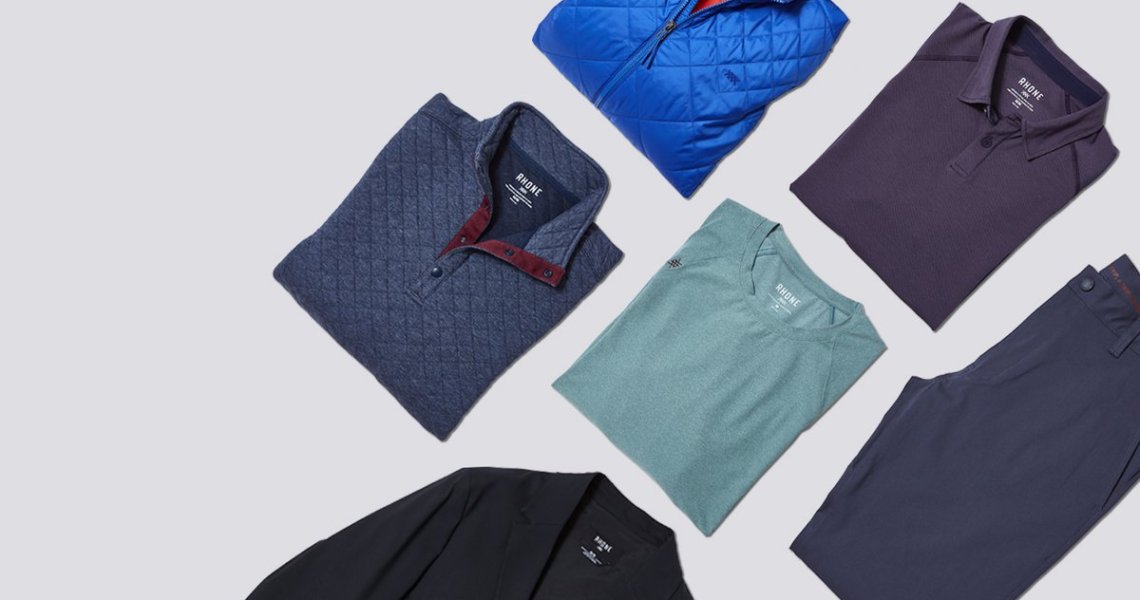The pandemic was good for activewear brands. Stuck inside, people craved comfortable clothes. Lululemon saw an 88% increase in sales in the first quarter of 2021, while Under Armour reported a 35% year-over-year increase in 2020.
But now, people are going back into the real world, complete with office hours and social events. So how are activewear brands dealing with the return to “normal”?
According to Ben Checketts, co-founder and creative director of DTC activewear brand Rhone, the key to maintaining momentum has been to focus on multi-use products that give people the comfort they’ve come to expect during Covid-19, but in silhouettes that are office-friendly.
Checketts said the brand has placed an increased emphasis on its commuter line, which includes chinos and button-down shirts but is made with the same performance material as many of its sweatpants. New additions like a band-collar polo shirt and several new pants styles “blur the line between lifestyle and lounge,” Checketts said. Since vaccinations began, Rhone has seen a 31% increase in sales of its commuter line.
In the last six months, these lifestyle products have grown to make up 60% of the brand’s sales, outstripping activewear. Rhone saw a 50% increase in total sales over the course of 2020. A new category on the Rhone online store, called Workleisure, was specifically created to house all of its hybrid clothes.
“You fell in love with sweatpants during the pandemic, so you buy dress pants that are as close as possible to sweatpants,” Checketts said.
According to a March survey from Cotton Incorporated, the number of consumers who say they’re primarily shopping for comfort increased from 63% in 2020 to 74% in 2021. In early July, Stitch Fix reported that searches for comfortable but office-appropriate clothes like jumpsuits and rompers were up 60%, while leggings and loungewear were down a corresponding 60%.
Ad position: web_incontent_pos1
Sarah Carlson, vp of product design at active brand Vuori, has seen non-active styles grow to become 50% of total sales in 2021.
Carlson declined to offer specifics on the company’s sales increase in the last year, but said growth, especially in the women’s business, was exponential. She said Vuori is leaning into the return to regular life with new styles launching in August that also fall into the hybrid category.
“I did a lot of research because I was concerned about whether people would wear ‘hard clothes’ again,” Carlson said, referring to stylish but less comfortable pieces like suits. “Most Americans are planning on updating their wardrobes, but the desire for comfort isn’t going away. The uptick in hybrid pieces is the natural response.”
Adidas is another brand that has been branching out from activewear. In June, the company announced a global expansion into underwear and lingerie — not active undergarments like sports bras, but traditional underwear and bras made from cotton, without the sporty edge that Adidas is known for. Victoria Vandagriff, president of the branded division at Delta, the company that manufactures Adidas’ new underwear line, said it was emphatically not meant to be an activewear product.
“This is a true underwear collection,” she said. “The fabrics are technical and the brand is a sport brand, but our focus is on making it look like a regular everyday bra, something you could wear all the time.”
Ad position: web_incontent_pos2
And the convergence of athletic clothes and everyday clothes is happening from both directions. While activewear brands are beefing up the amount of office-ready styles they have, traditional fashion brands are also launching active lines. Telfar is launching a sport line in September, while Pangaia launched a gym line at the end of June.




